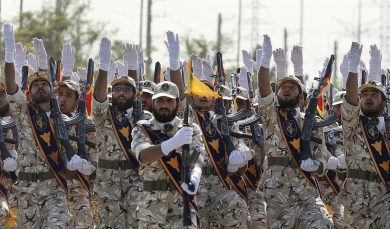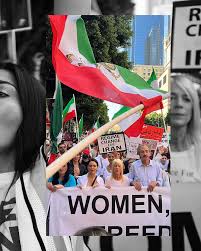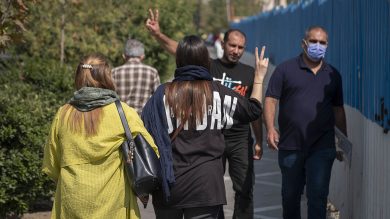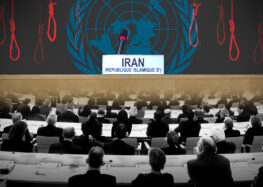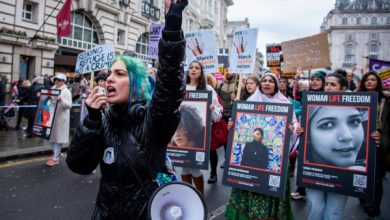In recent years, Iranian activists have faced severe repression at the hands of the Islamic Revolutionary Guard Corps (IRGC). Despite the threat of violence, imprisonment, and torture, protests have erupted across Iran, driven by demands for freedom, human rights, and social justice. These demonstrations, including the 2019 fuel price protests and the 2022 Mahsa Amini protests, reflect growing frustration with economic hardship, political corruption, and authoritarian rule. This report examines how activists are organizing and resisting the IRGC’s control, the tactics used by the IRGC to crush dissent, and the global response to Iran’s protest movements.
1. The Roots of Iran’s Protests
A. Economic Hardship and Corruption
Iran’s economy has deteriorated under mismanagement, corruption, and international sanctions, with inflation and unemployment pushing millions into poverty. Many protesters, particularly from working-class communities, demand economic reform and greater accountability.
B. Repression of Human Rights
• Activists have long protested against gender-based oppression, religious discrimination, and restrictions on free speech.
• The death of Mahsa Amini in 2022 ignited widespread protests, with women and youth demanding an end to compulsory hijab laws and police violence.
2. The IRGC’s Role in Suppressing Protests
The IRGC and its affiliated Basij militia are at the forefront of suppressing dissent. Their tactics include violence, surveillance, and psychological intimidation.
A. Use of Deadly Force
• During the 2019 fuel protests, IRGC forces reportedly killed over 1,500 protesters.
• In 2022, protesters in cities such as Sanandaj and Zahedan faced live ammunition and mass arrests.
B. Targeted Arrests and Torture
• Human rights organizations have documented cases of activists, journalists, and students being detained and subjected to torture.
• Detainees often endure forced confessions and lengthy prison sentences.
C. Digital Censorship and Surveillance
• The IRGC enforces internet blackouts during protests to limit communication and coordination among activists.
• Cyber units monitor social media, hacking activists’ accounts and spreading disinformation.
3. How Activists Are Resisting
Despite the severe risks, Iranian activists have developed creative tactics to mobilize and organize protests.
A. Underground Networks
• Activists form clandestine groups to plan demonstrations and evade IRGC surveillance.
• These networks provide safe spaces for organizing and sharing resources, including digital security tools.
B. Nonviolent Resistance
• Acts of civil disobedience—such as removing hijabs in public—have become symbolic forms of resistance.
• Women, students, and artists are using performance art, poetry, and music to express dissent.
C. Digital Activism
• Despite internet shutdowns, activists use VPNs, encrypted apps, and social media platforms to share protest footage.
• Hashtags like #MahsaAmini and #WomenLifeFreedom have spread globally, raising awareness and support.
4. Key Figures and Movements
Several activists and movements have gained prominence in Iran’s fight for freedom.
A. Women’s Rights Advocates
• Nasrin Sotoudeh, a prominent lawyer and human rights defender, has been repeatedly imprisoned for advocating for women’s rights.
• Women’s groups have led campaigns to abolish compulsory hijab laws and end gender discrimination.
B. Student Movements
• University students have held campus protests, calling for academic freedom and political reform.
• The IRGC has targeted student leaders with expulsions, arrests, and violence.
C. Ethnic and Religious Minorities
• Kurdish, Baloch, and Bahá’í activists face disproportionate repression, with the IRGC labeling them as separatists or threats to national security.
• Protests in regions like Kurdistan and Sistan-Baluchestan have faced particularly brutal crackdowns.
5. Global Response and Solidarity
A. International Protests
• Iranian diaspora communities have organized solidarity protests in cities like London, Berlin, and Washington D.C..
• Activists have called on foreign governments to hold the Iranian regime accountable for human rights violations.
B. Sanctions on the IRGC
• The United States, Canada, and the European Union have imposed sanctions on IRGC officials involved in repression.
• Activists continue to push for the IRGC’s designation as a terrorist organization to limit its resources.
C. Support from Human Rights Organizations
• Groups like Amnesty International and Human Rights Watch have documented IRGC abuses and called for independent investigations.
• The United Nations Human Rights Council has condemned Iran’s use of excessive force against protesters.
6. Challenges Facing the Movement
A. Severe Repression
• The IRGC’s tactics of violence, intimidation, and mass arrests have made sustained protests difficult.
• Many activists are forced into exile or hiding, limiting their ability to organize openly.
B. Censorship and Propaganda
• The regime’s control of state media spreads false narratives blaming protests on foreign interference.
• Activists face challenges in countering disinformation campaigns both inside and outside Iran.
7. The Path Forward
To sustain the fight for freedom, activists and their supporters must pursue long-term strategies:
A. Strengthening Global Advocacy
• Continued awareness campaigns and international pressure are essential to keep the world’s focus on Iran’s human rights crisis.
• Activists urge governments to prioritize human rights in diplomatic relations with Iran.
B. Expanding Digital Security
• Providing secure communication tools and training helps activists evade surveillance.
• Collaboration with tech companies can ensure that VPNs and encrypted platforms remain accessible in Iran.
C. Building Solidarity Networks
• Activists are forming alliances with feminist, labor, and minority rights organizations to strengthen their movement.
• Diaspora communities play a crucial role in amplifying Iranian voices on the global stage.
Conclusion
The Iranian protest movement represents a powerful call for freedom and human rights in the face of brutal repression by the IRGC. Activists continue to risk their lives to demand justice and democracy, inspiring solidarity across the globe. International support is vital to sustain this fight and hold the Iranian regime accountable for its crimes.
Join Our Newsletter!
Stay informed with the latest updates, news, and ways to take action in the fight for justice and global security. Sign up now to get updates delivered straight to your inbox!

